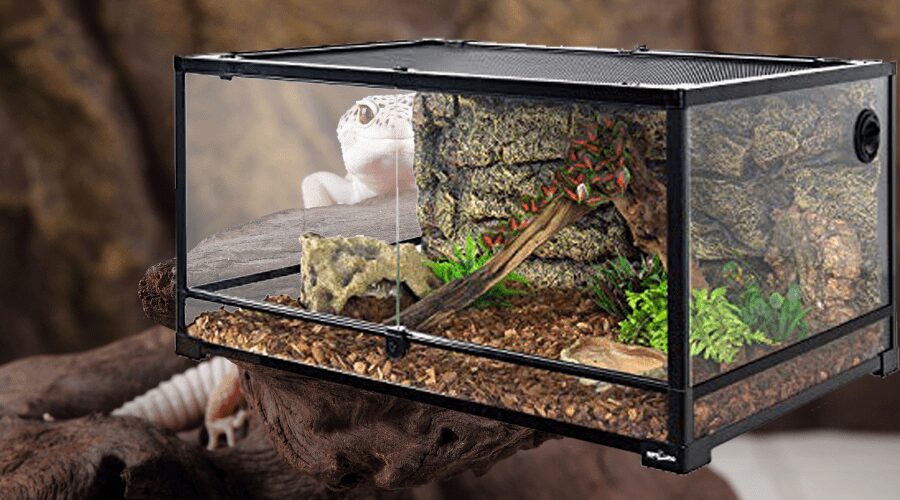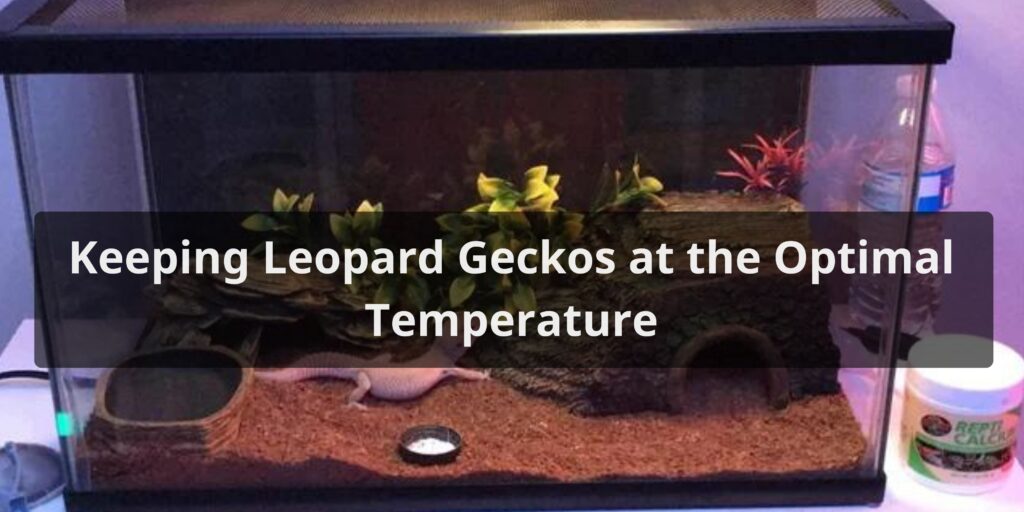Leopard geckos are a popular pet reptile known for their docile nature, ease of care, and wide range of morphs and colors. However, ensuring your leopard gecko thrives in captivity requires carefully managing the temperature in their tank. Maintaining proper temperatures is crucial for your leopard gecko’s health and allows them to carry out normal behaviors. Read on for a detailed guide to leopard gecko tank temperature.
Understanding Leopard Gecko Temperature Needs

Leopard geckos are native to the deserts of Asia and Pakistan. They are accustomed to hot daytime temperatures that can exceed 100°F, followed by much cooler nights. In the wild, leopard geckos behaviorally thermoregulate, moving between warmer and cooler areas as needed.
As ectothermic reptiles, leopard geckos cannot produce their own body heat. Instead, they depend on external heat sources to maintain an optimal core body temperature of around 88-93°F during the day. At night, they prefer temperatures of 70-75°F for comfortable resting.
These temperature gradients allow leopard geckos to properly digest food, metabolize nutrients, strengthen their immune system, and carry out natural behaviors like hunting and exploring. Temperatures that are too hot or cold will stress your pet and cause health issues.
Setting Up Proper Daytime Heating

Leopard geckos require supplemental heating in captivity to create the warm, desert-like conditions they thrive in. The main heat source for your leopard gecko habitat should be an under tank heating mat. These mats safely conduct heat through the bottom of the glass tank.
Place the UTH mat on one side of the tank, covering around 1/3 of the floor space. This creates a “warm side” temperature gradient. Use a thermostat to control the UTH and maintain a floor temperature of 88-93°F on the warm end. The cool end should stay around 75-80°F.
You can also use overhead heat bulbs or ceramic heat emitters during the day. These help raise the ambient air temperature to 85-90°F. Turn off all overhead heating at night to allow a natural drop in temps. Place thermometers at each end to monitor the gradient.
Providing Proper Nighttime Cooling

Just as daytime heat is vital, leopard geckos need milder temperatures at night to mimic natural conditions. Turn off all heating elements after 12-14 hours of daytime heat. The temperature in the tank should gradually drop to 65-75°F overnight.
Maintain nighttime temperatures in this range by using central air conditioning or a fan to cool the room. Do not allow the habitat to fall below 65°F, as this can cause health issues. The ambient and floor temperature gradient allows your leopard gecko to thermoregulate as needed overnight.
Maintaining Optimal Temperature and Humidity
In addition to heating, maintaining proper humidity levels will help your leopard gecko thrive. Leopard geckos fare best at a humidity level of 30-40%. Use hygrometers to monitor humidity and make adjustments as needed.
Proper temperatures and humidity work hand in hand. If the tank becomes too dry, temperatures can spike to dangerous levels under basking lights. Mist the tank 1-2 times per day avoiding moisture build up. Provide a humid hide with damp moss for shedding.
Signs of Improper Temperatures
Consistently incorrect temperatures will cause your leopard gecko stress and health problems. Signs that temperatures may be off include:
- Lethargy, weakness, or loss of appetite
- Hiding at all times and avoiding basking
- Darkening or lightening of color
- Frequent gaping or heavy breathing
- Shedding difficulties
- Weight loss
- Diarrhea
If you notice any of these symptoms, immediately check all temperatures in the habitat with reliable thermometers. Make any necessary adjustments to get temperatures back into the optimal 88-93°F (daytime) and 70-75°F (nighttime) ranges.
Conclusion
Caring for leopard geckos requires replicating the hot desert conditions they thrive in. Use under tank heating mats, overhead ceramic heat emitters, and ambient cooling to maintain a thermal gradient from 88-93°F during the day, and 70-75°F at night. Monitor temperatures carefully with thermometers. Adjust heating and cooling elements as needed to prevent temperature-related health issues. With the proper temperature ranges, you can keep your leopard gecko active and healthy.
FAQs About Leopard Gecko Tank Temperature
How should I set up a temperature gradient in the gecko’s enclosure?
To establish a temperature gradient, place a heat source (heat mat or lamp) on one side of the tank. This creates a warm area, with temperatures around 88-92°F (31-33°C). The opposite side remains cooler, around 70-75°F (21-24°C). This gradient allows geckos to choose their preferred temperature for thermoregulation.
Do leopard geckos require specific day and night temperatures?
Yes, leopard geckos do benefit from specific day and night temperatures. During the day, maintain the warm side at 88-92°F (31-33°C), and at night, allow the temperature to drop slightly to around 70-75°F (21-24°C). This mimics their natural temperature fluctuations, supporting their natural behaviors and sleep patterns.
What is the recommended temperature for the warm side of the tank?
The recommended temperature for the warm side of the tank is between 88-92°F (31-33°C). This temperature range is crucial for digestion, activity, and overall well-being. Use a thermostat to ensure accuracy and prevent overheating or temperature fluctuations.
How do I measure and maintain the tank temperature accurately?
Measure and maintain tank temperature accurately using reliable digital thermometers with probes. Place the probe at gecko level to monitor the temperature where they reside. Use heat mats, heat lamps, or both, depending on your setup, and a thermostat to control and maintain the desired temperature range.
Can I use heat lamps, heat mats, or both for temperature control?
Yes, you can use heat lamps, heat mats, or both for temperature control in a leopard gecko enclosure. Heat mats provide belly heat, while heat lamps offer overhead heating. The choice depends on your setup and the need to create a temperature gradient. Use a thermostat to regulate and ensure safety.



